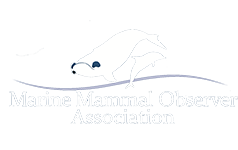The Marine Mammal Observer Association (MMOA) recommends that Passive Acoustic Monitoring (PAM) equipment and/or services, supplied for marine mammal mitigation purposes should comprise of the following (as a minimum);
- An appropriate length of cable to deploy the hydrophone(s) at a suitable distance and depth from the survey vessel and/or platform.
- Hydrophone elements with the correct frequency range for the expected species within the projects’ geographical location, especially those species that may result in delays and/or shutdowns of the project. This may mean multiple elements with differing frequency sensitivities.
- Appropriate sound cards (and back up drivers) with the appropriate sampling rate for and Species of Concern (SoC) and full instructions on their configuration.
- If using multiple hydrophone elements; full details of separation distances of each pair of elements for determination of bearing.
- GPS integration
- Calibrated depth sensor and full instructions on configuration.
- Filtering system for unwanted noise and full instructions on configuration.
- Professional noise cancelling headphones (with battery charger and/or spare batteries).
- Appropriate software for real time monitoring
- Full detailed manufacturers manual of assembly and calibration.
- Full inventory list of contents.
- Properly labeled shipping containers and reels.
- Timely and regular support from the PAM equipment provider for technical problems and configuration advice.
Additional recommendations for best practice:
- Incorporation of multiple (minimum of 2) hydrophone elements for each frequency range needed in order to provide bearing information for tracking animals.
- A backup of each component of the PAM equipment (including the smallest connectors) in case of equipment failures.
Using PAM alongside visual monitoring by Marine Mammal Observers (MMOs) greatly improves the possibility of marine mammal species being detected, however, clients, regulators and PAM Operator provider companies should be aware of several inherent limitations with the use of PAM for mitigation purposes. These points are important to understand when considering whether PAM is suitable for use as a sole monitoring method during darkness or other periods of limited visibility (i.e. whether it has a reasonable likelihood of reliably detecting the SoC present within a site).
Limitations of Passive Acoustic Monitoring (PAM):
- Many potential SoC will not be detected using PAM equipment because they do not produce vocalisations, or vocalise infrequently, for example sea turtles, sirenians, baleen whales, basking sharks, and many species of pinnipeds. If an animal is not vocalizing it may pass close to a PAM system but remain undetected.
- Limited ability to detect baleen whale vocalisations as typical PAM equipment used for mitigation purposes is usually deployed astern of large commercial vessels and in proximity to continuous low frequency engine noise. Propeller noise (together with water noise and the low frequency sound emitted by the airguns (or other sound source) themselves) can mask low frequency biological signals.
- Determining range in cases where baleen whales are occasionally detected can be difficult. For example, singing humpback whales can produce vocalisations, which travel over many kilometres, make it difficult to determine range and a PAM Operator may be unable to determine with any level of reliability whether an animal is within a mitigation zone.
- Species that vocalise at high frequencies will not be detected beyond short distances. For example, the reliable detection range for harbour porpoise signals is approximately 200-300m. These animals may be present within the MZ before being detected by PAM equipment. Therefore, a harbour porpoise may be present in the outer region of a MZ (e.g. 300-500m from the source) but not detected by a PAM system; however, high frequency vocalizations can be assumed to be within the mitigation zone.
- The vocal repertoires of some marine mammal species are poorly-described or unknown.
- Many marine mammal vocalisations, particularly the echolocation click trains produced by odontocetes, are directional in nature and may not be easily detected by PAM equipment if the animals are facing away from the hydrophone. For example harbour porpoises (which often show avoidance reactions to platforms) will not be detected when swimming away from a vessel’s track line.
- Range determination is only possible for some species through the tracking of bearing information over time, using the timing of signals arriving at pairs of hydrophone elements deployed at known distances from the ship’s stern and the ship’s GPS position. PAM systems with linear pairs of hydrophones are sometimes inadequate at providing suitable bearing information over a sufficient time, for accurate range determination.
- Range determination is not possible for a towed array deployed vertically from a static platform and in such situations all detections could be regarded as within the mitigation zone. Additionally several individual hydrophones not linked to form an array cannot localize on an acoustic signal and all detections could be regarded as within the mitigation zone.
The MMOA believes that the use of PAM equipment for mitigation purposes for many SoC should not be considered to represent a reliable sole method but rather should be used to enhance other mitigation measures. However, PAM is the only reliable method that allows detection and identification of animals underwater and can be used in darkness, fog and periods of reduced visibility, as well as most weather conditions. Effective operation is dependent on capable equipment, good deployment and competent operators.
PAM Detections and Noise Samples
The MMOA recommends that the use of PAM during a mitigation project should be objectively assessed for detection rates. This may be achieved with PAM recordings made during other mitigation surveys, or sound sample records for quality assessments (i.e. to gauge water noise and masking and determine how effective the PAM system was likely to be at detecting marine mammals in practice). The effectiveness of PAM for marine mammal mitigation purposes cannot be assessed without understanding the acoustic environment that the systems are being deployed in and the corresponding likelihood of detecting an animal. Modelling should be completed during any assessment phase of the project or programme.
Submission of PAM Data to Regulatory Bodies
The requirement for recordings of PAM detections to be submitted to a regulatory body is changing across jurisdictions. Should a project require submission and regulatory processes are in place to submit PAM recordings - it is necessary to follow the requirements of theregulator. Many jurisdictions do not yet require these types of submissions. The MMOA considers this best practice in order to:
- Assess the likelihood of acoustic detection for different SoC.
- Provide a means of assessing and validating the species identification of recorded acoustic detections.
- Provide a means of assessing the mitigation decisions made based on particular acoustic detections
- Provide opportunities for acoustic analysis research.
PAM data can be checked or verified for its effectiveness in mitigation surveys (in terms of equipment functioning properly, adequate ambient noise levels for making detections, the species and number of detections made, the provision of adequate range and bearing information and the consequent implementation of mitigation decisions).
Training for PAM Operators
Please see the MMOA’s Position Statement 5 - Passive Acoustic Monitoring (PAM) Operator Qualifications for a comprehensive list of (minimum) qualifications for PAM Operators.
The MMOA emphasises that the skills required to work effectively as a PAM Operator are difficult to acquire through short training courses, and require practical time at sea. Consequently, the MMOA recommends that organisations hiring PAM Operators for mitigation surveys seek to use personnel with proven previous field expertise with marine mammal acoustics. The MMOA does not promote the use of inexperienced PAM personnel as trainees offshore. The Association recommends that persons seeking acoustic monitoring experience achieve this by joining dedicated research projects (paid or otherwise) and through mentoring
opportunities.
It is recommended that projects introducing anthropogenic noise into the marine environment should have a marine mammal or fauna mitigation plan with a description of all mammal acoustics of species commonly encountered in the project area. It is the responsibility of the PAM operator to ensure they are familiar with the likely range of species and subsequently the vocalisations likely to be encountered.

